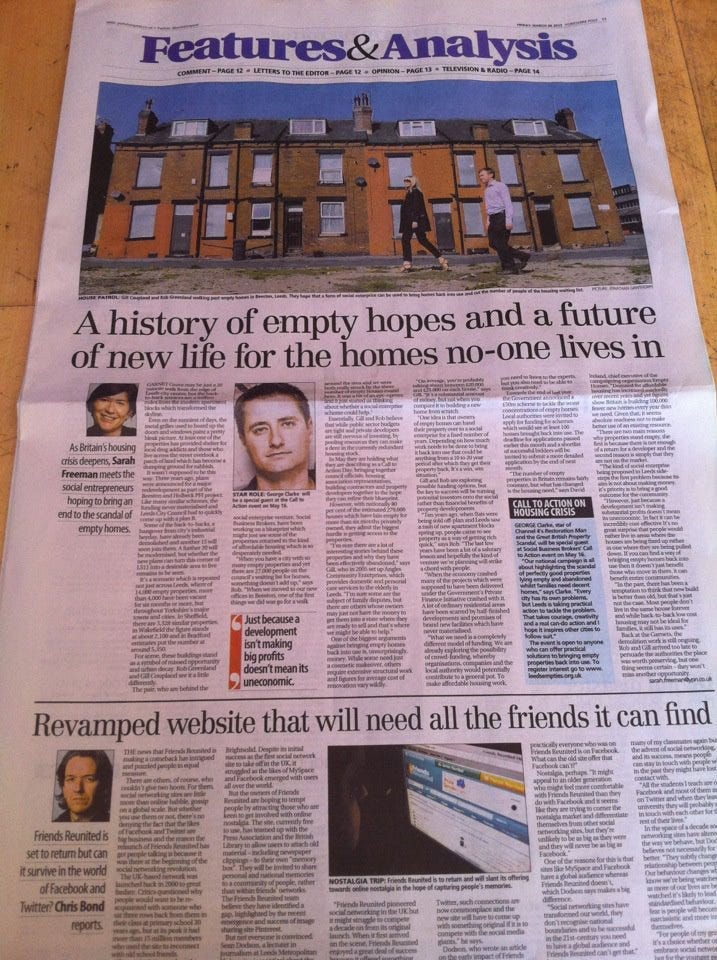Do we need more empty homes?
Would the housing market work better if there were more empty homes?
Tom Forth from Leeds-based Open Innovations has been on You and Yours a couple of times over the last few weeks making the case that we need more empty homes. The latest conversation is below, and he goes into more detail here.
You and Yours - 19/04/2022 - BBC Sounds
Catch up on your favourite BBC radio show from your favourite DJ right here, whenever you like. Listen without limits…www.bbc.co.uk
If you follow what the social enterprise that I co-founded in 2010 gets up to, you might be wondering exactly why we’ve spent much of that time helping to reduce the number of empty homes.
Our Empty Homes Doctor service, which we set up in 2013, works alongside the empty homes team at Leeds City Council to bring long-term empty properties back into use.
I’ve told the story of how we went about setting up the service here — and I’ve reflected on some of the challenges of changing things where you live here. So I won’t go into that detail again now.
But I wanted to build upon some of the points Tom makes, and to offer further context.
First things first. I think the broader point that Tom is making (he goes into detail here) is one I agree with. We’re not building enough homes. We have a crisis of affordable housing supply, however far you stretch the meaning of the term affordable.
And the case that Tom is making is that when compared with other countries, the percentage of homes that are vacant at any one time in this country is very low. You can check the percentage for where you live here. This contributes to being very difficult for people to buy or rent an affordable home.
There is clearly an issue here — as anyone who’s tried to buy or rent a home at pretty much any time over the last 20 years will tell you. There is a clear imabalance between supply and demand and that doesn’t work well for people trying to find somewhere affordable to live.
But I don’t think it follows that a higher number of empty homes would necessarily be a good thing.
In short, that’s because there are all sorts of empty homes.
We could certainly do with a greater supply of homes — available to move into immediately or to renovate.
But the issue is that not all empty homes are available for people to purchase or rent.
Two different figures tend to be used for counting empty properties.
One is a figure for homes that have been empty for less than six months.
The other is a “long-term-empty” figure — relating to homes that have been empty for over six months. This will naturally be lower than the first figure.
If, like us, you’re trying to sort out problematic empty properties, you mostly ignore the first figure. It includes the “market churn” that is healthy in any well-functioning housing market. Typically the time between one person selling and another moving in. Or a short period between tenancies.
It’s when a home has been empty for more than six months that people like us tend to get involved.
And as I’ve explored elsewhere, there can be various things going on there. A complicated probate process perhaps. Or maybe an older person moving into care. Or an owner with a mental health issue, who’s maybe had to move out after their home became uninhabitable.
These are the homes that can also cause wider societal problems, as well as real difficulties for the owners themselves.
Teams of people from across the public sector can end up involved. Homes can cause problems for neighbours — ranging from damp from an adjacent leaky gutter through to people moving in and running a cannabis farm on your nice quiet street.
Most empty homes aren’t problematic like this. Typically we might get a 5% response rate to letters that we write on a monthly basis to people who own a long-term-empty property in Leeds.
Alongside that, the number of empty properties the Council’s team might get involved with each year (typically to threaten or undertake enforcement action — which can in extreme cases result in a Compulsory Purchase Order) will be somewhere in the low hundreds.
Meanwhile, thousands of homes will become temporarily vacant, and end up back in use weeks or months later, with no problems at all.
So yes, although it can sound counter-intuitive, there is some truth in Tom’s case that we don’t have enough empty homes. But it doesn’t necessarily follow that an increase in the number of empty properties would result in, or be an indicator of, a housing market in which more people are able to rent or buy affordable homes.
There are all sorts of other issues at play here, and - to bring it back to Leeds - our housing market was highly dysfunctional ten years ago when we had twice as many long-term empty homes as we do today. It’s even more dysfunctional now (unless you’re an investor, in which case you could argue it’s working pretty well).
So whilst the number of empty properties may be one indicator of an imbalance between supply and demand, there are much bigger problems to solve. Problems which won’t, in my opinion, be solved by “trusting markets more”.
A housing market with more empty homes in it won’t necessarily be one that works any better for ordinary people than the one we’ve got today. Unless of course you trust that the market will act in the best interests of the majority of us. Which, as you might have guessed, is not what I believe.





